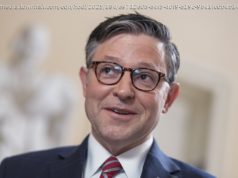President Trump is pushing forward with his promise to take a harder line on legal immigration.
President Trump is pushing forward with his promise to take a harder line on legal as well as illegal immigration, endorsing on Wednesday a Senate proposal to slash the number of foreigners admitted to the United States while favoring those with certain education levels and skills.
Although the proposal would not quite mean the “biggest change in 50 years” to the immigration system, as Trump described it, its provisions would upend decades of policy and fundamentally challenge the nation’s openness to immigrants as symbolized by the Statue of Liberty.
The bill faces dim prospects in Congress, however. Nearly all Democrats and a sizable number of Republicans are opposed. But Trump’s embrace of the legislation, from Republican Sens. Tom Cotton of Arkansas and David Perdue of Georgia, is in keeping with a core promise of his campaign and reflects his intensified emphasis in recent weeks to appeal to his core supporters.
The current U. S. immigration system favors uniting family members with relatives already in the country and was built on the premise that any person, regardless of what language they speak, how much education or money they have, can seek to come to the United States.
Under the bill, admissions would be based on a point system that would give foreign applicants a higher score if they speak English, have a job offer that pays above the median wage, can financially support themselves and have skills that “can contribute to our economy, ” Trump said. He called it a “merit-based” system similar to that used in Australia and Canada.
“For decades, the United States was operated and has operated a very low-skill immigration system, issuing record numbers of green cards to low-wage immigrants, ” Trump said, announcing his support for the proposal at the White House with Cotton and Perdue, who drafted the legislation together with administration officials.
“This policy has placed substantial pressure on American workers, taxpayers and community resources, ” he said.
At a time when the total of refugees globally exceeds the levels of World War II, the proposal would limit the number given lawful permanent residence each year to 50,000.
The annual Diversity Visa lottery would be eliminated. Each year, that lottery selects 50,000 winners, many from countries in Africa and Eastern Europe, who along with their spouses and minor children can obtain green cards and work in the United States.
The proposal “ends chain migration” of extended family members, Trump said, by giving preference only to the spouses and minor children of legal residents, but not adult children and other relatives.
That change, he added, reflects his administration’s “compassion for struggling American families that deserve an immigrant system that puts their needs first.”
The proposal has been praised by hard-line immigration groups, including NumbersUSA and the Federation of Immigration Reform, that advocate for lower immigration levels. But immigration advocacy groups are opposed, as are many economists who say the nation, with an aging population and low fertility rate, should be encouraging an influx of younger workers to spur economic growth.
Prospects for the proposed immigration overhaul are not good. Any such changes would require support from moderate Republican senators such as John McCain of Arizona and Lindsey Graham of South Carolina, and many Senate Democrats oppose making partial changes to immigration law without creating a pathway to legal status for immigrants who arrived in the country illegally and put down roots.
Graham wrote on Twitter that the proposal would be devastating to the South Carolina economy, which relies heavily on an immigrant workforce in the agricultural and tourism industries.
For Trump, supporting the reduction in overall legal immigration is a reversal. He has repeatedly said he doesn’t want to reduce the total number of immigrants admitted each year, yet the proposal by Cotton and Perdue would cut the annual influx of immigrants from the current rate of 1 million per year to about 500,000.
Trump has also been reluctant to end the Deferred Action for Childhood Arrivals program, started by President Obama, which provides work authorizations to immigrants brought to the U. S. illegally as children. Trump called the program unconstitutional during the presidential campaign, but also has expressed sympathy toward people who are in this country illegally through no fault of their own and were raised here.
White House senior advisor Stephen Miller, when asked whether the Trump administration was trying to change the promise enshrined by the Emma Lazarus poem on the base of the Statue of Liberty, said, “The poem you were referring to was added later and was not part of the original Statue of Liberty.”
Miller, like Trump, said the restrictions on low-skilled entrants were necessary to guard against taking jobs from Americans and driving down wages. Yet he defended Trump’s use of temporary foreign workers on his resort properties.
“This bill of course doesn’ t deal with guest workers and temporary non-immigrant visas, ” Miller said.
He said that Trump defended his business practices during the campaign by saying that “as a businessman my responsibility is to operate by the laws of the United States as they exist.”
But, Miller continued, “He said, as president, my responsibility is to pass laws that make sure we have an immigration system that prioritizes American workers.”
Trump has not proposed to change the program that his company has long used.
Twitter: @ByBrianBennett
brian.bennett@latimes.com
ALSO
Watch CNN’s Jim Acosta and White House advisor Stephen Miller’s heated exchange over Trump’s immigration policy
Trump quietly signs Russia sanctions bill
Justice Department to examine race-based admissions in universities






